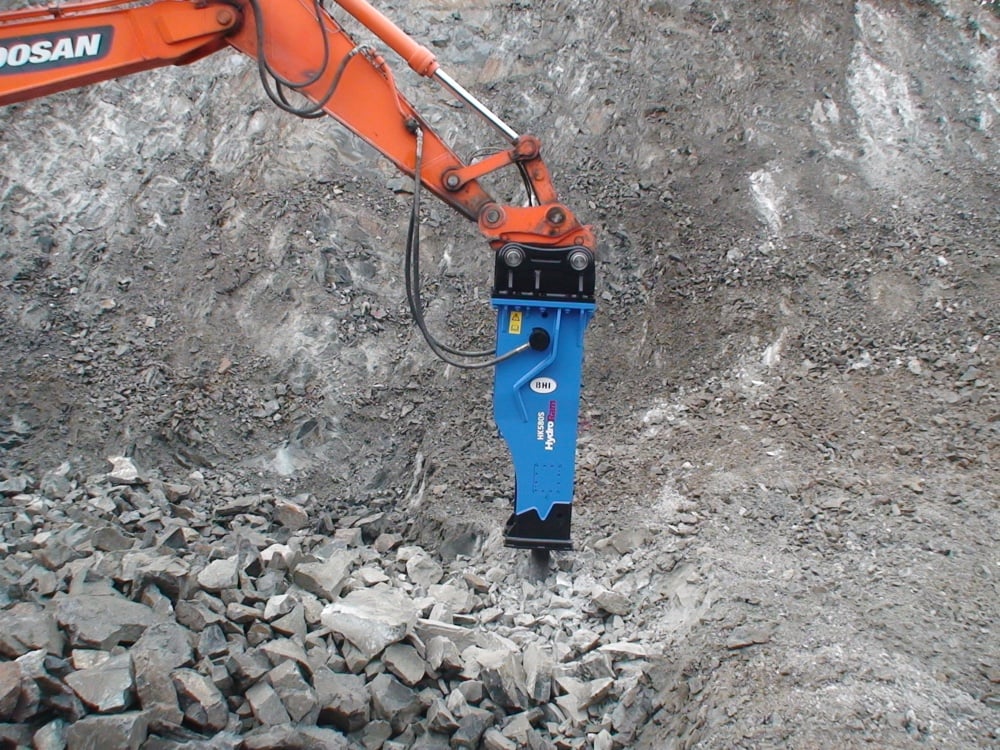Positioning the Hydraulic Hammer
It’s important to properly position so that it’s perpendicular to the material and to follow this rule when using the hydraulic hammer/hydraulic breaker so that it can correctly test the hardness of the material. If the hydraulic hammer/hydraulic breaker is improperly aligned, it could respond as though it was working in light material and remain in a high frequency, low impact mode. When it is properly aligned, it selects the best frequency impact combination for maximum performance with that material at that particular time.
Installing the Hydraulic Hammer
During installation, it is recommended that the hydraulic hammer runs in a vertical position at about 250-300 blows per minute for one hour. All hydraulic hammers must have sufficient pressure against the tool to allow the transmission of energy or the shock wave to flow through the tool to the material being broken. As the tool moves through the material, the applied pressure is continuously adjusted by using a combination of the boom, dipper and attachment control so that the hydraulic hammer follows the tool. If the applied pressure is insufficient, the tool will dance around on the material rather than sending energy into the rock. When this happens, an impact created by the piston is not transmitted to the rock as a shock wave but is absorbed by the hydraulic hammer and excavator causing abnormal structural fatigue. Applied pressure should not lift the carrier high off the ground. As the hydraulic hammer breaks through the material, the excavator will drop suddenly and harmful shock loads will be transmitted to the tool, power cell, Operation of Hydro Ram Hydraulic Hammers and excavator. If the hydraulic hammer is too heavy for the excavator, the resulting damage will be worse.
Things to Avoid with a Hydraulic Hammer
Avoid Blank Fire Operations at All Times. If this happens, the piston will strike the tool shank with full impact, forcing the tool against the retainers and causing premature wear and failure to the tool, tool retainers, piston, chuck housing, tension bolts and the hydraulic hammer itself. And since there is no material to absorb the energy, the shock waves will bounce back up the tool, meeting other waves coming down the tool in violent collisions. These collisions create a disorganized mass of energy, causing extensive wear and tear to the tool and other hydraulic hammer components.
Never use a hydraulic hammer for lifting or prying something, not only this is dangerous, but also it can cause damage to the hydraulic hammer, tool, and bushings. It also causes damage to other hydraulic hammer components as well as reducing productivity. Prying inhibits of the shock wave through the tool and creates heat buildup in the bushing area.
In Cold Weather, always Warm Your Equipment Up Properly Before Operating After the carrier is warmed up, suspend the hydraulic hammer in the air (with the tool extended) to activate the automatic stop. Activate the control to circulate the oil and warm the hydraulic hammer. Warm the tool bit by operating at slow speeds for five to ten minutes.
Never Let the hydraulic hammer Strike On the same spot for more than 30 seconds. Even 30 seconds can be too long for large hydraulic Hammers. Working in one spot too long causes heat buildup in the tool, resulting in loss of tool strength and wear resistance.

